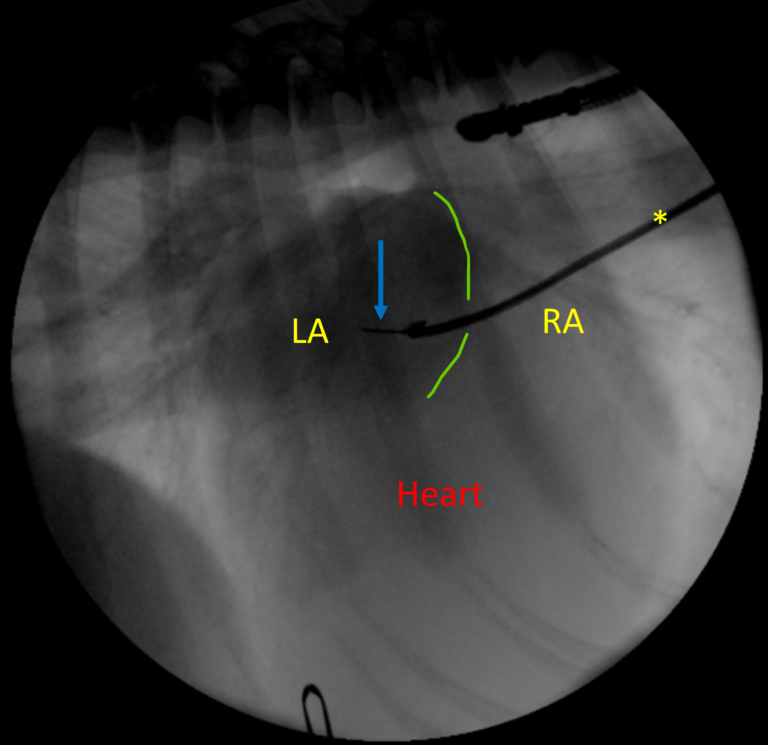Why Should I Bring my Pet to Willows for Left Atrial Decompression?
Willows is one of Europe’s leading small animal referral centres. Our state-of-the-art hospital is led by internationally renowned Certified Specialists committed to providing the highest standards of veterinary care. Our team of Specialist Cardiologists are supported by our multidisciplinary team of Specialists across a number of disciplines, including; Anaesthesia, Diagnostic Imaging, Soft Tissue Surgery and Emergency and Critical Care.
In addition, Willows has a large, dedicated team of nurses and clinical support staff available 24 hours a day, every day of the year to provide the best possible care for your pet.
What is a Transeptal Puncture?
Transeptal Puncture (TSP) is a minimally invasive, catheter-based procedure. A TSP is known as a ‘beating-heart intervention’; carried out without the need to open the chest or the heart and is performed via catheterisation which involves passing a thin, flexible tube (known as a catheter) from the right through to the left side of the heart.
Certain cardiac diseases can cause fluid to build up in the lungs due to higher-than-usual pressures within the heart (particularly in the left atrium). This procedure aims to relieve the abnormal pressures and reduce fluid within the lungs resulting from heart failure.
A Transeptal Puncture procedure is performed under general anaesthetic through a small incision in the neck allowing catheters to be guided into the heart through a large vessel called the jugular vein. The procedure is performed under fluoroscopic (continuous X-rays images) and transoesophageal echocardiography (ultrasound of the heart performed via a probe placed in the oesophagus) guidance. This allows correct positioning of the catheters and needles within the right and left atrium.
Typically, patients that undergo TSP are discharged from the hospital the day after surgery.

The image shows a fluoroscopy recording during a Transeptal puncture. The catheter is passing between two chambers of the heart and is then used to create a communication between these chambers and allow relief of the excessively high pressure in the left atrium.

What are the Most Common Reasons for Transeptal Puncture?
Left atrial decompression is a palliative therapy. Dogs and cats that are suitable for left atrial decompression include those with heart failure and concurrent renal disease or that have advanced heart failure but continue to have symptoms despite optimal medical treatment. This means that despite appropriate medical treatment, these patients continue to show signs such as breathing difficulties, exercise intolerance, signs of renal failure, weight loss, excessive urine production and/or thirst.
What are the Benefits of a Transeptal Puncture?
Early clinical evaluation of the TSP procedure in humans over the last few years has shown improved quality of life and reduced clinical signs in patients with heart failure. The procedure has also been associated with low-risk and a meaningful drop in left atrial pressure which is associated with improved quality of life of the affected patients. Patients typically are discharged the day after the procedure.
What Can I Expect if my Pet Undergoes a Transeptal Puncture?
The improvement in heart chamber pressures via TSP often allows reduction in the dose of water tablets (diuretics). Water tablets are used to control the heart failure signs (e.g., fluid in the lungs (pulmonary edema). Lowering the dose reduces the risks of side effects related to these drugs. This has a significant beneficial impact on the patient’s quality of life and potentially on the long-term outcome.
Long-term Management
Dogs that have undergone a TSP will return to the care of the referring cardiologist after the procedure. Regular follow-up evaluations by the referring cardiologist would be recommended for any pet affected by heart failure.
To save this page as a PDF, click the button and make sure “Save as PDF” is selected.
Cardiology
Find out more
To assist owners in understanding more about the conditions related to and treatments available for patients with heart and lung problems, we have put together a range of information sheets to talk you through the some of the more common cardiology conditions seen by our Specialists.

